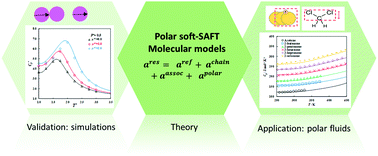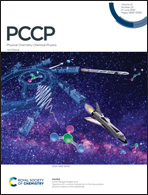Polar soft-SAFT: theory and comparison with molecular simulations and experimental data of pure polar fluids†
Abstract
The consideration of polar interactions is of vital importance for the development of predictive and accurate thermodynamic models for polar fluids, as they govern most of their thermodynamic properties, making them highly non-ideal fluids. We present here for the first time the extension of the soft-SAFT equation of state (EoS), named polar soft-SAFT, to explicitly model intermolecular polar interactions (dipolar and quadrupolar), using the approach of Jog and Chapman (P. K. Jog and W. G. Chapman, Mol. Phys., 1999, 97(3), 307–319). The theory is first validated using molecular simulation data for a wide range of polar model systems including Stockmayer fluids, LJ dimers with dipole, and quadrupolar LJ fluids, for a wide range of thermophysical properties such as liquid density, vapour pressure, surface tension and heat capacities. Excellent agreement between polar soft-SAFT and simulation data has been obtained for all examined fluids and properties for systems exhibiting low to intermediate polar strength, while the agreement deteriorates at very high polar strengths. Once validated with simulations, the equation has been applied to calculate vapour–liquid equilibria (VLE), surface tension and second-order derivative properties of systems such as 2-ketone and methane chloride families as showcases for dipolar fluids and the benzene family for quadrupolar fluids, finding very good agreement with experimental data. In order to preserve the robustness of the model, the experimental value of the dipole or quadrupole was used in these calculations, while the additional parameter for the polar fluids was set a priori rather than included in the fitting procedure. The excellent agreement found with simulations and experiments empowers the soft-SAFT equation with new capabilities for the development of robust and accurate molecular models of polar fluids of industrial relevance.



 Please wait while we load your content...
Please wait while we load your content...